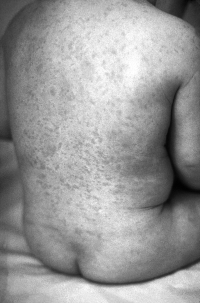Childhood Diseases: Rubella
Rubella
Rubella, also called German measles, is a very contagious disease caused by a virus. The virus causes fever, swollen lymph nodes behind the ears, and a rash that starts on the face and then spreads to the torso and arms and legs. Rubella is not usually serious in children, but can be very serious if a pregnant woman becomes infected. Fortunately, rubella is no longer common, because since 1969 most children are vaccinated for it with the MMR vaccine when they are a year old.
Rubella is spread when a person breathes in droplets of coughs or sneezes from an infected person. A person can spread the disease for several days before the rash appears and for up to a week after the rash goes away.
Infectious Knowledge
In 1964 and 1965, 20,000 babies were born with birth defects due to a rubella outbreak. The outbreak also caused 10,000 miscarriages and stillbirths.
Potent Fact
The MMR and DPT vaccines each protect against three diseases:
MMR: measles, mumps, rubella
DPT: diphtheria, pertussis, tetanus
Rubella is caused by a different virus than the one that causes regular measles, so children need to have both a measles and a rubella vaccine.

Rash of rubella on the skin of a child's back. Distribution of the rash is similar to that of measles, but the lesions are less intensely red. (Courtesy CDC)

Excerpted from The Complete Idiot's Guide to Dangerous Diseases and Epidemics © 2002 by David Perlin, Ph.D., and Ann Cohen. All rights reserved including the right of reproduction in whole or in part in any form. Used by arrangement with Alpha Books, a member of Penguin Group (USA) Inc.







